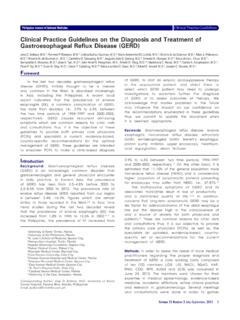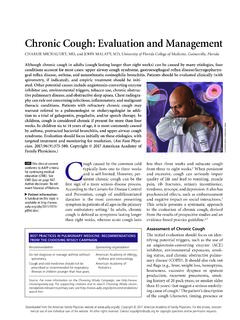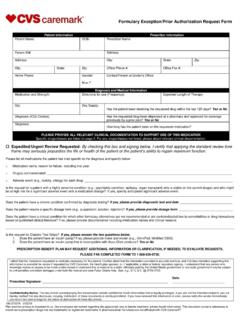Transcription of DRUG NAME: Pembrolizumab - BC Cancer
1 Pembrolizumab DRUG NAME: Pembrolizumab SYNONYM(S): lambrolizumab1, MK-34752 COMMON TRADE NAME(S): KEYTRUDA CLASSIFICATION: miscellaneous Special pediatric considerations are noted when applicable, otherwise adult provisions apply. MECHANISM OF ACTION: Pembrolizumab is a selective humanized IgG4 monoclonal antibody known as a programmed cell death 1 (PD-1) immune checkpoint inhibitor. The PD-1 pathway is an immune control checkpoint that may be exploited by tumour cells to escape active T-cell surveillance. By blocking PD-1 receptors from binding to immune dampening PD-1 and PD- 2 ligands expressed on antigen presenting tumour cells, Pembrolizumab reactivates tumour-specific cytotoxic T-lymphocytes in the tumour microenvironment and restimulates anti-tumour PHARMACOKINETICS: Distribution limited extravascular distribution cross blood brain barrier?
2 No information found volume of distribution L plasma protein binding 0% Metabolism catabolized through non-specific pathways; metabolism does not contribute to its clearance3 active metabolite(s) no information found inactive metabolite(s) no information found Excretion linear clearance from the central compartment urine no information found feces no information found terminal half life 26 days clearance L/day Adapted from standard reference3 unless specified otherwise. USES: Primary uses: Other uses: *Melanoma *Lung Cancer , non-small cell *Health Canada approved indication SPECIAL PRECAUTIONS: Caution: avoid systemic corticosteroids or immunosuppressants prior to starting Pembrolizumab due to potential interference with the efficacy of Pembrolizumab ; corticosteroids or immunosuppressants may be used during treatment with Pembrolizumab for the management of immune-mediated adverse BC Cancer Drug Manual Page 1 of 7 Pembrolizumab Developed: 1 June 2016 Revised: 1 April 2018 Pembrolizumab Carcinogenicity: no information found Mutagenicity: no information found Fertility: Developmental toxicity studies have not been conducted.
3 In repeat dose studies in cynomolgus monkeys, no noteworthy effects were detected in male or female reproductive organs; however, the significance of these results is unknown as most of the animals in these studies were sexually Pregnancy: Pembrolizumab has not been studied in pregnant women. Endogenous IgG4 is known to cross the placental barrier, particularly during the third trimester; therefore, as a humanized IgG4 antibody, Pembrolizumab is expected to be transmitted from mother to fetus. In murine models, blocking PD-L1 signaling has disrupted tolerance to the fetus and resulted in increased rates of abortion and stillbirth. Women of reproductive potential should use effective contraception while on Pembrolizumab and for four months after treatment has been Breastfeeding is not recommended due to potential secretion of Pembrolizumab into breast milk.
4 Human IgG4 is known to be secreted into breast milk; therefore, as a humanized IgG4 antibody, Pembrolizumab may also be passed from mother to nursing child. Avoid breastfeeding while on Pembrolizumab and for 4 months following the last ,4 SIDE EFFECTS: The table includes adverse events that presented during drug treatment but may not necessarily have a causal relationship with the drug. Because clinical trials are conducted under very specific conditions, the adverse event rates observed may not reflect the rates observed in clinical practice. Adverse events are generally included if they were reported in more than 1% of patients in the product monograph or pivotal trials, and/or determined to be clinically ,6 ORGAN SITE SIDE EFFECT Clinically important side effects are in bold, italics blood and lymphatic system/ febrile neutropenia anemia (12-58%, severe 5-8%)3,4 lymphopenia (25%, severe 4-10%) thrombocytopenia (2%) ear and labyrinth vertigo (2%) endocrine (see paragraph following Side Effects table) hyperthyroidism (1-2%) hypophysitis (2%, severe 1%) hypothyroidism (4-7%) eye dry eye (2%) uveitis (<1%) visual impairment (2%) gastrointestinal (see paragraph following Side Effects table) emetogenic potential.
5 Low7 abdominal pain (3-12%)3,4 colitis (1%) constipation (5-21%)3,4 diarrhea (11-20%, severe 1%)3,4 dry mouth (2%) gastroesophageal reflux disease (3%) nausea (8-30%)3,4 pancreatitis (<1%) vomiting (3-16%)3,4 general disorders and extravasation hazard: none8 BC Cancer Drug Manual Page 2 of 7 Pembrolizumab Developed: 1 June 2016 Revised: 1 April 2018 Pembrolizumab ORGAN SITE SIDE EFFECT Clinically important side effects are in bold, italics administration site conditions asthenia (6-7%) chest pain, non-cardiac (2%) chills (4-14%)3,4 face edema (2%); peripheral edema (4-17%)3,4 fatigue (33-47%, severe 6%)3,4 influenza like illness (2%) pain (2%) pyrexia (3-12%)3,4 hepatobiliary hepatitis (1%); see paragraph following Side Effects table immune system (see paragraph following Side Effects table) colitis, including microscopic colitis (1%, severe 1%)3,4 hepatitis (1%, severe <1%) hyperthyroidism (1-2%, severe <1%)3,4 hypophysitis (1%, severe <1%)3,4 hypothyroidism (7-9%)3,4 infusion related reaction (<1%) nephritis (<1%); includes renal failure with evidence of interstitial nephritis pneumonitis (1-3%).
6 Has been fatal rash (<1%)4 infections and infestations upper respiratory tract infection (11%)4 cellulitis (2%)4 pneumonia (2%)4 sepsis (10%)4 investigations (see paragraph following Side Effects table) alkaline phosphatase increase (23-26%, severe 1%)3,4 ALT increase (16-21%, severe 1%) AST increase (18-28%, severe 2%) hypercholesterolemia (11-21%, severe 1%) weight loss (2-3%) metabolism and nutrition appetite decrease (6-26%)3,4 hyperglycemia (40-52%, severe 3-4%)3,4; see paragraph following Side Effects table hypertriglyceridemia (23-30%)3,4 hypoalbuminemia (32-43%)3,4 hypocalcemia (24-25%, severe 1%) hyponatremia (29-40%, severe 9%)3,4 musculoskeletal and connective tissue arthralgia (14-20%)3,4 back pain (2-12%)3,4 muscle spasms (2%) muscular weakness (3-5%, severe1%) myalgia (5-14%)3,4 myositis (<1%) pain in extremity (2-18%, severe 1%)3,4 neoplasms tumour pain (1-2%) nervous system dizziness (2-11%)3,4 headache (4-16%)3,4 BC Cancer Drug Manual Page 3 of 7 Pembrolizumab Developed: 1 June 2016 Revised.
7 1 April 2018 Pembrolizumab ORGAN SITE SIDE EFFECT Clinically important side effects are in bold, italics hypoesthesia (3%) lethargy (5%) paraesthesia (1%) peripheral neuropathy (1-4%) psychiatric insomnia (14%)4 renal and urinary renal failure (2 %)4; see paragraph following Side Effects table respiratory, thoracic and mediastinal cough (7-30%)3,4 dyspnea (8-23%, severe 1%) pleural effusion (2%)4 pneumonitis (1-4%, severe 1%)3,4; see paragraph following Side Effects table wheezing (2%) skin and subcutaneous tissue blisters9 (1%) dry skin (2%) erythema (2-6%) night sweats (1-5%) pruritus (12-30%)3,4 rash (1-29%, severe 1%)3,4 Stevens-Johnson syndrome, toxic epidermal necrolysis9,10 (<1%); sometimes fatal vitiligo (9-11%)3,4 vascular pulmonary embolism (2%)4 Adapted from standard reference3 unless specified otherwise.
8 Severe infusion reactions are rarely reported. Patients with mild or moderate infusion reactions may receive Pembrolizumab with close monitoring and premedication in concordance with local infusion reaction prophylaxis guidelines. Permanently discontinue Pembrolizumab following a severe or life threatening Immune-mediated adverse events are a spectrum of side effects caused by general immunologic enhancement that can occur at any time during Pembrolizumab treatment or months after discontinuation. Consider the etiology of reported endocrinopathy, diarrhea/colitis, hepatitis, nephritis, and pneumonitis to be immune-mediated until another etiology is confirmed. Symptoms can be severe or fatal if not recognized and treated quickly; therefore patients should not self-treat without medical advice.
9 Management of symptoms depends on the severity of the reaction and may require treatment interruption and/or administration of corticosteroids. Corticosteroids should be appropriately tapered following resolution of symptoms to Grade 1 or less. Pembrolizumab may be restarted following completion of the steroid taper depending on the severity of the initial reaction. Based on limited data, immunosuppressants may be administered if adverse reactions are not controlled by corticosteroids. Referral to appropriate medical specialty may be required to manage other immune-mediated complications related to treatment. Antibiotic prophylaxis should be considered for patients on long term corticosteroid treatment ( , oral trimethoprim/sulfamethoxazole for the prevention of Pneumocystis jiroveci pneumonia).
10 Permanently discontinue Pembrolizumab for: life-threatening reactions (excluding endocrinopathies controlled with hormone replacement therapy), corticosteroid dose that cannot be tapered to prednisone 10 mg daily or less within 12 weeks, persistent Grade 2 or 3 reactions that do not improve to Grade 0 or 1 within 12 weeks of last dose, or recurrent Grade 3 ,4,11,12 Immune-mediated endocrinopathies may present as nonspecific symptoms ( , extreme weakness, vision changes, dizziness or fainting, or muscle aches). BC Cancer Drug Manual Page 4 of 7 Pembrolizumab Developed: 1 June 2016 Revised: 1 April 2018 Pembrolizumab Commonly reported endocrinopathies are outlined below: hypophysitis, including hypopituitarism ( , headache, fatigue) and secondary adrenal insufficiency ( , dehydration, hypotension, electrolyte imbalances); autoimmune thyroid disease, including hyper- and hypothyroidism; Type 1 diabetes mellitus and diabetic ketoacidosis.












